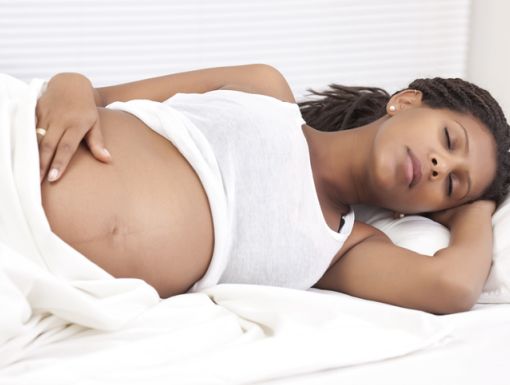
What Do Contractions Feel Like?
As you near your due date, your nerves may start kicking in. Every little feeling might make you think you are going into labor, and you may be wondering what true contractions will feel like. Here is what you need to know to prepare yourself.
What is a contraction?
A contraction occurs when your uterus (or womb) begins to tighten. Contractions typically start in the third trimester, but they can begin as early as mid-pregnancy.
It is important to know that not all contractions mean you are going into labor. Some contractions, like Braxton Hicks contractions (also known as false labor), can occur during your pregnancy and are usually categorized as unpredictable, sporadic and non-rhythmical contractions. Braxton Hicks contractions are not considered actual labor because they do not cause cervical change.
True labor contractions usually occur after 37 weeks or once you are near your due date. They occur in regular intervals and get closer together as time goes on. These contractions help move a baby downward by tightening the top of the uterus and applying pressure on the cervix; this pressure causes the cervix to open or dilate.
Contractions that occur before 37 weeks may be a sign of preterm labor (real labor happening before your baby is ready to be born). If you experience them, you should contact your OB/GYN right away or head straight to the hospital.
How contractions feel will vary from one person to the next, from one pregnancy to the next and will depend on what type of contraction you are having.
What do Braxton Hicks contractions feel like?
Braxton Hicks contractions can be described as tightening in the abdomen that comes and goes. For many pregnancies, Braxton Hicks contractions are tolerable and not disruptive of day-to-day activities.
But for some pregnancies, they are very disruptive because of the pain, discomfort and lack of sleep they cause. Some even result in trips to the hospital to rule out labor. Fortunately, these types of Braxton Hicks contractions occur near the end of pregnancy and are short-lived.
Braxton Hicks contractions are:
- Unpredictable. You might have one every 10 minutes, then 20 minutes.
- Irregular in intensity. You can laugh and talk through a contraction, but then the next one brings you to tears.
- Non-rhythmic. One contraction lasts two minutes, and another lasts 20 seconds.
- Contractions might stop when you hydrate (drink a lot of water), walk or rest, or might even stop when you change position.
What do labor contractions feel like?
True labor contractions are often described like waves. The intensity of them slowly rises, peaks and then slowly decreases. Some laboring patients also describe labor contractions as extreme menstrual cramps or even diarrhea cramps. You might also experience:
- Dull backache
- Pelvic pressure
- Pain that radiates from your back to the front of your core
Labor contractions can last anywhere from a few seconds to a few minutes. It’s time to call labor and delivery for further instructions and see your doctor for evaluation once contractions are regular in frequency and:
- Occurring less than four minutes apart
- Regular in duration, with each lasting 40 seconds or more
- Regular in intensity and getting stronger by the minute
In addition to experiencing contractions in a regular pattern, other signs you are going into labor include:
- Your water breaking
- Vaginal discharge that may contain blood
- Diarrhea
- Nausea and vomiting
What do back contractions feel like?
Another type of contraction is called back contractions. It can be caused by your baby’s position in the uterus, and it is a more focused type of pain that patients may feel during labor contractions. Some patients describe it as severe lower back pain that doesn’t go away in between uterine contractions and intensifies during them.
How can I alleviate contraction pain?
There is no “tried and true” method that works for everyone. If you are experiencing Braxton Hicks contractions, try:
- Changing positions. You can lie down if you have been standing, or go for a walk if you have been sitting or laying.
- Taking a warm bath for 30 minutes or less.
- Drinking water. Sometimes contractions may be brought on by dehydration.
If you are experiencing labor or back contractions, you can try:
- Breathing exercises. Breathing techniques can help focus your mind and loosen muscle tension.
- Walking. Getting up and moving around can help distract you from labor pain and assist during the delivery by letting gravity help the baby descend in the birth canal.
- Massage therapy. Massage can be used to help reduce tension in the muscles. There are various techniques that can be used for massage therapy, so be sure to find one that works best for you and your body.
- Aromatherapy. Certain essential oils have been shown to have soothing properties during labor. Lavender, for example, has been studied to help reduce anxiety. Try using warm and hot compresses to stimulate the essential oils. It is important to note that not all essential oils should be used by pregnant patients. Talk to your provider to discuss which ones are safe.
- Moving into different positions. Try squatting, lunging, sitting on a ball or doing pelvic tilts.
- An epidural. This form of regional anesthesia can also help with the pain. It reduces or blocks feeling, including pain, below your waist. You can begin an epidural at any time during your labor — in the beginning, in the middle or even toward the end — in consultation with your physician. You remain awake and alert, but you’ll probably experience loss of feeling in the lower half of your body. Those with an epidural will not be able to walk around.
At the end of the day, you should do whatever feels most comfortable for you when it comes to managing contraction pain. The priority is making sure you have an enjoyable experience and that you and your baby are healthy!
If you are unsure if you are experiencing actual labor contractions, talk with your doctor, and they will help determine the best next steps.
To learn what to expect when expecting at Ochsner, visit Ochsner.org/newmom.



